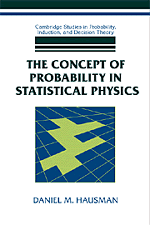Book contents
- Frontmatter
- Contents
- Introduction
- Chapter 1 The Neo-Laplacian Approach to Statistical Mechanics
- Chapter 2 Subjectivism and the Ergodic Approach
- Chapter 3 The Haar Measure
- Chapter 4 Measure and Topology in Statistical Mechanics
- Chapter 5 Three Solutions
- Appendix I Mathematical Preliminaries
- Appendix II On the Foundations of Probability
- Appendix III Probability in Nonequilibrium Statistical Mechanics
- Author Index
- Subject Index
Chapter 4 - Measure and Topology in Statistical Mechanics
Published online by Cambridge University Press: 12 November 2009
- Frontmatter
- Contents
- Introduction
- Chapter 1 The Neo-Laplacian Approach to Statistical Mechanics
- Chapter 2 Subjectivism and the Ergodic Approach
- Chapter 3 The Haar Measure
- Chapter 4 Measure and Topology in Statistical Mechanics
- Chapter 5 Three Solutions
- Appendix I Mathematical Preliminaries
- Appendix II On the Foundations of Probability
- Appendix III Probability in Nonequilibrium Statistical Mechanics
- Author Index
- Subject Index
Summary
THE NATURALIST CONCEPTION OF PHYSICS
In the previous chapters we were occupied with the dual theme of the centrality and the problematic character of the frequentist's conception of probabilities in the context of SM. On the positive side, the frequentist's conception links the probabilities directly with the laws of physics, because the calculation of frequencies is effected through an integration along the trajectories formed by the successive solutions of the equations of motion. However, because there are in general many such trajectories, to each there corresponds a different value of the frequencies.
We saw in Chapter 3 how, in the case of a system with a single degree of freedom, there is only a single possible trajectory that the system may follow, and hence a single way of calculating the frequencies. In this case, which is the “best-case scenario” from the frequentist's point of view, it is possible to reduce the probabilities to relative frequencies. However, we have seen that this case is exceptional from a physical point of view, and so we have determined it necessary to reformulate the frequentist's standpoint.
One reaction to the failure of the simple frequentist's conception is the idea that, rather than calculating the exact frequencies along individual trajectories, we should calculate the average of the frequencies among the members of a set of trajectories. Having done that, we may ask whether these averages are different relative to the choice of different sets of trajectories (ergodic systems have the property that the different sets will yield the same averages).
- Type
- Chapter
- Information
- The Concept of Probability in Statistical Physics , pp. 151 - 189Publisher: Cambridge University PressPrint publication year: 1999

